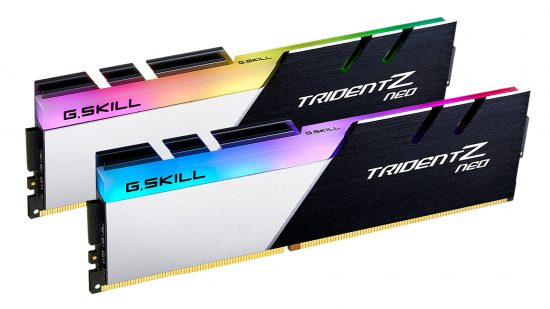Our Verdict
82%Still a solid choice, but Corsair’s Vengeance RGB Pro kits offer better value at current prices.
When AMD’s first Ryzen CPUs launched in 2017, there was a scramble for compatible memory modules, and any DIMMs based on Samsung B-die memory chips sold like hot cakes thanks to their enhanced compatibility at speeds beyond 2933MHz.
One company rubbing its hands was G.Skill, as its Trident Z gaming memory used these chips, unlike many other memory makers’ kits at the time, including those from Corsair. The new G.Skill Trident Z Neo modules are still sold as Ryzen-optimized now, although Ryzen memory compatibility has since been much improved.
At Custom PC, we’ve been reviewing the latest memory since 2003, and we’ve tested and overclocked hundreds of kits, going right back to the original DDR era. We run both synthetic and application benchmarks to assess performance, and also see how far we can overclock each kit. In addition, we look at any RGB lighting features and assess how good it looks, as well as how well the control software works. For more information, check out our How we test page.
Again, the Trident Z Neo modules mainly use Samsung B-die memory chips, although there’s no guarantee here – sometimes you get chips from SK Hynix, depending on the date of manufacture and the latency timings you choose. They’re not quite as cheap as Corsair’s Vengeance Pro RGB modules either, but at under £100, they’re still not hugely overpriced.
The main difference between the standard Trident Z kits and the new Neo ones is the heatsinks, with the newer Neo modules offering silver slabs on both sides; not surprisingly, this matched the peak temperature of the G.Skill Trident Z Royal modules at 48°C. We prefer the look of the newer modules to the old ones, but the lighting is the same as far as we could tell, with a large diffusing bar sitting on top of the LEDs.
To control the lighting, you have the option of using G.Skill’s own Trident Z software or ASRock, Asus, Gigabyte or MSI’s own lighting software, although both Corsair and Kingston’s software are superior in terms of features and design.
The lighting looks great, though, and the modules’ lighting areas sit very close together, looking great if you can fill adjacent slots. As such, it’s a shame G.Skill doesn’t sell dummy modules, like the Light Enhancement kits for Corsair’s Vengeance Pro RGB memory.
G.Skill Trident Z Neo performance
While the Trident Z Neo’s performance in our AIDA64 Extreme synthetic tests didn’t particularly stand out – for example, the 68.7ns latency was bettered by three other kits we’ve recently tested – it still held its own in our RealBench tests, bettering four other kits we’ve recently tested with a score of 222,032.
G.Skill Trident Z Neo overclocking
Our 3600MHz G.Skill Trident Z Neo kit would only overclock to a frequency of 3866MHz, though, matching other kits based on Samsung chips, such as the Corsair Vengeance RGB Pro.
Again, you’ll need to dial these higher frequencies into your EFI in order to get the best results in AMD’s systems by matching them with the fabric clock, otherwise you’ll see slower results despite the higher frequency. Plus, if high-frequency operation is your priority, the Kingston Fury Beast DDR4 RGB kit fared better, hitting 4000MHz.
G.Skill Trident Z Neo pros and cons
Pros
- Attractive heatsinks
- Universal motherboard software compatibility
- Reasonable overclocking potential
Cons
- Low-latency kits are hard to find
- Lighting control can vary between motherboard models
- Competition is either cheaper or faster
G.Skill Trident Z Neo spec
The G.Skill Trident Z Neo specs list is:
| Memory chip | Samsung B-die |
| Effective frequency | 3600MHz |
| Timings | 18-22-22-42 |
| Voltage | 1.35V |
| Height (from base) | 44mm |
| RGB software compatibility | Asus Aura Sync, Gigabyte RGB Fusion 2.0, MSI Mystic Light Sync, ASRock Polychrome Sync |
G.Skill Trident Z Neo price
Price: Expect to pay $95 (£91).
G.Skill Trident Z Neo review conclusion
With many kits using dies offering favorable AMD support, and Ryzen memory compatibility improving, G.Skill has lost its advantage and can now only compete on price and features.
It’s outgunned by cheaper kits such as the Corsair Vengeance RGB Pro, which is noticeably cheaper and offers better software control as well as dummy kits, while the Kingston Fury Beast DDR4 RGB costs the same price, but can overclock further and has a higher out-of-the-box frequency.
This leaves the Trident Z RGB Neo, and the original Trident Z RGB kits for that matter, at the mercy of pricing, and this has fluctuated a lot in recent months.
Ultimately, the Trident Z Neo modules look great, have snazzy RGB lighting and are a good fit with AMD Ryzen systems, as are most modules these days. However, at current pricing, Corsair’s Vengeance RGB Pro kits offer much better value.
